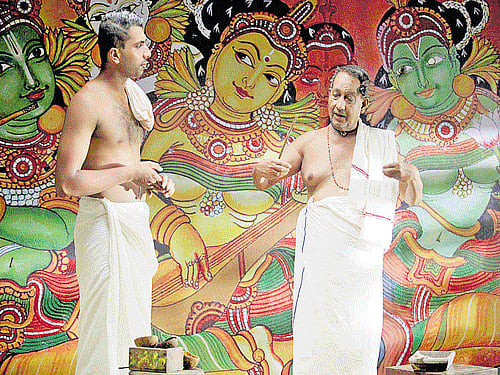
How relevant is Sanskrit as a language in the popular culture of our times? G Prabha, a Sanskrit professor who is helming what could be the first social-themed film in the language, believes that its relevance could be shaped only with relentless efforts to help it break free — from its complexities, grammatical rigours and more critically, perceptions of its exclusiveness and Brahminical affiliation.
In the run-up to the formal launch of Ishti in Ernakulam, the filmmaker is monitoring final touches in pre-production — “The budget is low and there are no exclusive production teams, this is a project put together by a group of friends,” he says — and tells you that the film, at some levels, also tries to demystify the language.
A treasured legacy
“Sanskrit is a rich, deep language with a set of exhaustive strictures that could have alienated the masses from it. But it does make sense to bridge that gap with a popular medium like cinema,” says Prabha, who has also written the film. India has made four Sanskrit features, prominent among them being late G V Iyer’s Bhagavad Gita and Adi Shankaracharya. Vishakhadatta’s play Mudrarakshasa has also been adapted to film. The latest feature to appear in the language is Vinod Mankara’s Priyamanasam, based on the life of 17th century poet-scholar Unnayi Warrier. For Ishti — set in Kerala of the early 1940s — the challenge, and opportunity, will be in having men and women converse in a language identified with the gods and saints.
The film, in its core, deals with regressions of an orthodox community and is set against the backdrop of a Namboothiri family. It’s also a commentary of the times, a take on that elusive sense of balance between worldly desires and the spiritual poise and asceticism that religion (or caste) celebrates. Ishti is anchored in its two central characters: Ramavikraman Namboothiri, a 71-year-old Vedic scholar who preserves the fire from a somayagam he had performed to light his funeral pyre, and Sridevi, Namboothiri’s 17-year-old wife — his third — who questions the orthodoxy of the community and even inspires her husband’s son from another marriage to read and write. The contrast between the film’s two leads is marked. The eventual discord in their marriage is also defined by men and women around them; people like the Apfan Namboothiri, the younger brother in the family who, according to Namboothiri custom, is not allowed to marry from within the community.
Reflecting cultures
“The Apfans were allowed to have alliances with Sudra women, but were not allowed to mingle with their children from these relationships; the children were also denied any right to inherit the fathers’ property. Ishti does talk about patriarchal oppression but it is essentially an attempt to look at men and women who are pitted against the regressive force of their community,” says Prabha, former head of the department of Oriental Languages at Loyola College, Chennai. Prabha’s earlier works include Agnaye, a documentary on Athirathram, the 12-day yagna, and Akkitham, a documentary on the life of Akkitham Achuthan Namboothiri.
Ishti features veteran National Award-winning actor Nedumudi Venu, Jijoy P R, actor and associate professor at the FTII, and Athira Patel. National Award-winning make-up artist Pattanam Rasheed and popular lyricist-musician Kaithapram Damodaran Namboothiri are part of the crew.
Prabha hopes to showcase Ishti in film festivals. He dismisses possibilities of the language limiting the film’s reach. “Ishti had to be made in Sanskrit because it’s also about the language breaking free. The appeal, for me, is also in having Sanskrit as conversational language in a film that addresses the issues of that very community,” he says.
